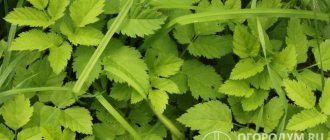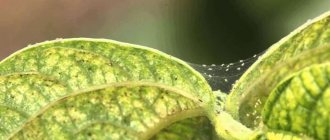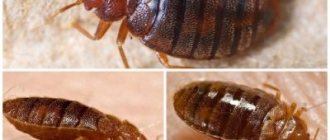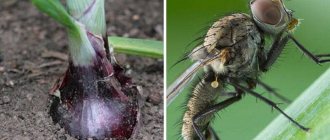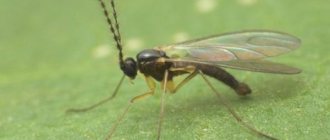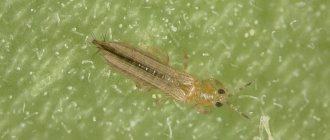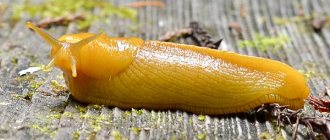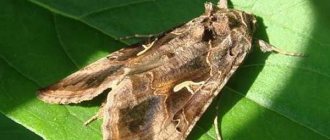Whitefly in the garden
Despite its modest size, this insect can pose a serious threat to anyone involved in agricultural production. Indeed, the problem is not the size of the whitefly, but the number of insects and their ability to move quickly. The length of the common European whitefly barely reaches 3 millimeters, its wings are covered with a waxy coating, slightly reminiscent of flour - hence the name of the pest (Photograph).
The whitefly is polyphagous; it can feed on the juices of various plants, including weeds. The peak population of the pest occurs in the second half of summer, when weather conditions are most favorable for its reproduction. This insect survives the winter in the ground, where it feels quite comfortable under the snow.
It should be noted that whitefly affects not only vegetables (cabbage, peppers) and berries (strawberries, wild strawberries), but also many garden and greenhouse plants. Moreover, the pest sometimes enters houses and apartments and destroys home flowers.
Mostly plants in open ground suffer from whitefly, but the parasite can also penetrate into greenhouses. If you do not fight the pest, you can lose the crop, but first you need to detect the insect. Usually the whitefly appears on the lower part of the leaves, they are covered with small white spots, and a shiny coating appears on the upper part of the leaf.
When they touch the plant, the insects fly away, but if you look at the lower part of the leaves, you can find small white dots - these are whitefly eggs, which after a while will turn into larvae. After a few more days, they leave their puparium and begin an independent life. It is the larvae that cause the greatest harm to plants, sucking out the nutritious juices from them. But the main problem is not even this - moving along the leaves, the larvae cover them with their feces, in which various fungi settle. In turn, the fungus covers the leaves with a black coating, which prevents sunlight from entering. No sun - no photosynthesis, no photosynthesis - no plant.
How to get rid of whiteflies on seedlings at home
It is very difficult to get rid of the pest. Larvae, like adult butterflies, are very voracious. Having settled on a plant, they quickly create large colonies, which are very difficult to cope with. And sometimes only the use of combined methods can positively solve this problem.
Due to the very small size and almost transparent larvae, it is quite difficult to identify insects in the early stages. Therefore, as a rule, pest control begins late, when fairly large colonies appear. However, the fight must begin as soon as the whitefly is discovered. Since the pest can be at different stages of its development, control is carried out in combination, using different methods:
- mechanical,
- folk,
- biological,
- chemical.
Mechanical methods of struggle
This method is suitable when the prevalence of the pest is still small and has not reached critical values. And also when, for various reasons, you do not want to use chemicals. But it’s worth warning right away that if there is a large population of whiteflies on plants, this method will not be very effective. The essence of the method is the use of sticky traps.
For this purpose, you can use ordinary sticky tapes, which are sold in any hardware store and are used to control flies, or buy special yellow sticky traps. It is necessary to hang such traps near the affected plants and change them periodically, since the sticky layer dries out over time, and there are already enough flies on them.
You can make such a trap with your own hands. To do this, take thick paper like cardboard of yellow or blue color (for some reason, these are the colors that attract insects more), and grease it with rosin, honey, Vaseline, and entomological glue. These products do not dry out for a long time and therefore serve as a good trap for pests.
A regular light bulb also works well. The parasite is attracted to a bright light and flies towards it, burning its wings.
Traditional methods of dealing with whitefly
These methods, widely used by gardeners in their plots, are also effective against small numbers of parasites. And they are also good because they can be used at home on seedlings.
- Tobacco . It is set on fire and its smoke is used to fumigate seedlings at home or plants in a greenhouse. Or water the plants with infusion prepared in water and infused for 5 days.
- Potassium permanganate . Make a pink solution of potassium permanganate by diluting 5 g of potassium permanganate in 10 liters of water. Stir well until the crystals dissolve well in the water. Then the resulting solution is sprayed onto the plants and the soil under them is watered.
- Garlic . 200 g of chopped garlic is poured into 1 liter of warm water and left to infuse for a week in a tightly closed container. After a week, filter the infusion and bring the volume to 10 liters of water and spray the affected plants with the resulting solution.
- Dandelion . 40 g of clean crushed leaves and roots are poured into 1 liter of boiling water, left to steep for 2 hours, then filtered. Add 1-2 tbsp per 1 liter of liquid. l. liquid soap as an adhesive, stir the infusion well and spray the plants.
- Yarrow . 80 g of dry raw materials are poured into 1 liter of boiling water and left for 1 day. Then filter and spray the plants. For greater effect, wipe all the leaves on the plants with a sponge soaked in the infusion, and also water the soil under the seedlings.
- Benzyl benzoate is a pharmaceutical product that is used to treat scabies and control lice. 20-50 ml of the product (depending on the age of the seedlings) are diluted in 1 liter of water, stirred and sprayed on the plants from all sides once a week.
When spraying, be sure to try to ensure that the applied products get on the underside of the leaf blade, because this is where insects and their larvae are located.
Biological agents
The essence of this method is to sow plants such as the Ageratum flower or the American weed (Galinsoga) among seedlings or plants in a greenhouse. This agrotechnical technique, of course, will not allow you to destroy the pest completely and immediately, but it is like a beacon and will allow you to detect its presence on plants in time and contain its further spread. The emerging pests are drawn to these plants like honey. And if you periodically inspect the plants, you can notice the whitefly in time and destroy it before it proliferates too much.
Ageratum contains substances (juices) that sterilize the whitefly, so it cannot reproduce further. The number of the pest will fall, even if it remains somewhere. How much ageratum should I plant? According to the canons, 0.1% of the total number of planted plants is required. But in practice, at least 1 plant per 10 square meters is sufficient. m.
Another American plant (Galinsoga) has a similar effect as Ageratum. But this weed produces a lot of seeds, so when planting it on a plot, do not wait until it blooms and produces seeds. It is better to pick off the flowers in advance and burn them, since the seeds can ripen even far from the mother plant.
Folk methods of struggle
Let us immediately note that it is very difficult to fight this insect. Adults are generally difficult to destroy with anything, and larvae are not so easy to kill. In addition, there are no effective preventive methods to prevent the appearance of whiteflies (although greenhouse prevention can and should be done). However, not everything is so sad. Over many years of fighting the pest, gardeners have invented a lot of folk remedies that, when used correctly, can give good results.
Infusion of tar. To prepare a remedy against whiteflies, take 30 milliliters of birch tar and try to mix it with 10 liters of water. That's what we're trying to do, since tar doesn't dissolve well in water. Then, using a broom (a sprayer is not suitable because tar clogs the nozzles), we process the vegetables. However, there is an easier way to combat the pest: instead of tar, use tar soap. It dissolves well in warm water; moreover, such a solution does not contaminate the sprayer and helps to get rid of pests for a while.
We prepare safe products with our own hands
The preparation of products according to folk recipes has already been discussed, so we need to focus on mechanical methods. Making a Glue Trap:
- Paint the plastic pieces yellow.
- After drying, cover with entomological glue.
- Attach lighting and hang the trap at the level of the tops of the plants.
In 1 hour, up to 80–85% of whiteflies will stick to this structure. At night, you can set another trap: place a light bulb painted yellow in a box, make holes at its level, and immerse a container of water in the bottom.
Chemicals to combat whitefly
If you have not been able to destroy or at least scare away the whitefly from your site using traditional methods, you need to use more effective methods in the fight against this pest.
Fitoverm. The instructions for use indicate that this insectoacaricide of contact-intestinal action is quite effective in the fight against aphids, whiteflies and various types of mites. The poison protects plants in open ground, depending on humidity and ambient temperature, for 5 to 15 days. In a greenhouse, the period of protective action is longer: 12 -20 days.
Resort conditions for whiteflies
Butterflies love it when it is very warm and there is a high level of humidity in the air. Most often, the pest appears in abnormally hot summers with frequent precipitation. When the air temperature drops below 10 degrees, the aphids die and the larvae stop growing. But the parasite eggs remain intact and easily tolerate the cold.
Thus, along with the soil, the pest successfully enters greenhouses or conservatories. It will be difficult to smoke it out of there; the entire area will need to be treated. Aphids appear in plant nurseries where several rules are not followed:
– you can’t plant plants close to each other;
– the room must have ventilation and normal temperature;
– plants are planted only in prepared soil, pre-treated with pest control drugs;
– plants need to be fertilized and biostimulants added to the soil;
– you cannot spray plants at high humidity in the greenhouse.
In general, you can get rid of whiteflies using both folk and chemical means. Not every property owner wants to buy insect poisons. The bottom line is that a certain percentage of the poisons are absorbed by the plant, and the product will no longer be completely natural. This is especially true for vegetables such as cauliflower and white cabbage, broccoli, and blue cabbage. If you grow vegetables for your table, be careful with chemicals.
Fighting whiteflies in greenhouses
There are several reasons why whiteflies may appear in your greenhouse. First of all, we are talking about insufficient ventilation of the room, as well as the fact that you did not take any preventive measures against the insect. Unlike open areas, you can prepare for the appearance of a pest in a greenhouse. Whiteflies are controlled using the same methods as other pests. In early spring, the soil needs to be dug up and disinfected; for this you can use both folk remedies and chemicals (for example, Aktara).
Biological methods
Chemical preparations against whiteflies are gradually losing their relevance. Biological methods of control are being replaced. Examples:
- Placing encarsia pupae in greenhouses. The female parasite lays eggs in the bodies of whitefly larvae, which leads to death. Encarsia pupae are launched 2 weeks before planting.
- Macrolophus bug. Tobacco and greenhouse whiteflies are destroyed. These bugs are released before the active development of the pest. Against whiteflies, 1 insect per 1 m² is enough.
The colonization of greenhouses and greenhouses with entomophages is characterized by an efficiency of up to 99%. Biological enemies are especially useful for pests on tomatoes. Cucumbers contain hairs on the surface, which prevents entomophages.
On a note! Common natural enemies of whiteflies are the lacewing fly, ladybug, and ichneumon beetle.
Advantages and disadvantages of chemicals
Advantages:
- Large selection of pest control products on the market;
- Have a prolonged action;
- Effectively destroy whiteflies and other harmful insects;
- Some chemicals contain substances that stimulate plant growth.
Flaws:
- High cost of certain chemicals;
- Some insecticides tend to accumulate in the soil and fruits;
- Some drugs pose a threat to humans, animals and beneficial insects.
Features of the pest
The whitefly can settle on almost any vegetable, garden, flower and indoor crops. She has no special preferences, so when the insect appears in a garden bed or greenhouse, it destroys all the plants in a row.
Adults and larvae of whiteflies settle in large colonies and not only eat green matter, but are also carriers of fungi and viruses. Most often, simultaneously with a pest attack, plants are affected by diseases such as chlorosis, leaf deformation, and viral phytopathogenic infections. This further aggravates the problem, since crops that the butterfly does not have time to destroy may die from the disease.
Related article:
Diseases of cabbage in open ground: description with photographs
The duration of transformation of the larva into a full-fledged individual is 3 weeks. At this time, the caterpillar feeds heavily and causes even more damage than the butterfly itself. Damaged leaves darken and fungal and other infections develop on them. At this stage, it is no longer possible to save the plants and in most cases they die. Therefore, it is extremely important to detect the pest in time and begin to fight it.
Reviews from gardeners about methods of controlling whiteflies
Ekaterina Ivakhnitskaya, 41 years old. Sverdlovsk region:
Apparently this year there is an invasion of whiteflies in our Sverdlovsk region. For me and my neighbors, this harmful insect not only appeared on the site, but also entered the greenhouse. I can’t imagine where it came from so much - after all, in our climate it does not survive in winter. I think she is going to spend the winter in a greenhouse - after harvesting, she will have to set up smoke bombs, in general, wage an active fight. And now I’m fighting with Admiral and Aktara. It seems to me that these drugs kill adult insects, but the larvae survive.
Stepan Smetkovsky, 39 years old, Moscow region:
I have three greenhouses, and every year I have to fight a difficult battle against all sorts of pests, including whiteflies. It is clear that in the spring I put up tobacco blocks and disinfect the soil, but the insect still penetrates. For a long time I lost a significant part of the harvest. Two years ago, the Teppeki insecticide went on sale. I looked at reviews from gardeners, read an article on Wikipedia and decided to try it, despite the rather high price. I’ll say right away - an excellent result; already in the first year, the loss of vegetables did not exceed 10 percent. The whitefly begins to die within half an hour after treating the plants; the active effect of the drug continues for about five days after spraying. Now I use only this chemical in pest control.
Signs of whitefly infection of an indoor flower
It is not difficult to guess the appearance of whitefly butterflies on your pets based on some signs:
- At the slightest touch to the plant, they fly up above the flower pot like a white cloud and settle on nearby flowers, shelves, even on the windowsill.
- On the upper side of the leaf you can see spots of a shiny sticky coating, similar to sugary stains. This whitefly secretes honeydew (honeydew) on the surface of the leaves - traces of its vital activity.
- On the underside of the leaves, you can see clusters of adult insects, eggs and larvae that look like white translucent scales.
- First white and then black spots appear on the affected leaves - this is the result of the development of sooty fungus - the eternal companion of honeydew.
- The indoor plant noticeably lags behind in growth, stops developing, the leaves turn yellow and fall off, and it may die.
Preventive actions
Prevention is the best way to protect your plants from whiteflies. It is done quite simply.
These insects appear where there is high humidity, which is combined with elevated temperatures. In greenhouses, whiteflies can also be attracted to dense plantings that interfere with normal air circulation. Based on these facts, we can draw the following conclusion - in order to prevent the invasion of the parasite, it is enough to provide the crops with a constant flow of fresh air, normalize the temperature and humidity.
Plus, it is advisable to equip the windows of greenhouses and greenhouses with a fine mesh. Autumn digging and disinfection of the soil will not be superfluous. And be sure to clear the soil of fallen leaves and other plant debris, since thanks to them the whitefly can survive the winter quite safely. After harvesting and clearing the greenhouse of tops, you can also use sulfur bombs - they are set on fire and left overnight, and in the morning the top layer of soil, in which the larvae usually hide, is removed. After such an event, the whitefly disappears forever.
In addition, some strengthening drugs can have a preventive effect - a plant with good immunity will withstand a whitefly attack much easier. In addition, most of these products will cleanse crop tissue from poisons and toxins and improve the taste of the fruit.

